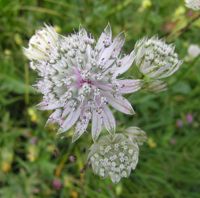Great Masterwort
| subsp. var. | Great Masterwort | |||||||||||||||||||||||||||||||||||||||||||||||||||||||
|---|---|---|---|---|---|---|---|---|---|---|---|---|---|---|---|---|---|---|---|---|---|---|---|---|---|---|---|---|---|---|---|---|---|---|---|---|---|---|---|---|---|---|---|---|---|---|---|---|---|---|---|---|---|---|---|---|

|
|
| ||||||||||||||||||||||||||||||||||||||||||||||||||||||
| ||||||||||||||||||||||||||||||||||||||||||||||||||||||||
| Standard Cyclopedia of Horticulture |
|---|
|
Astrantia major, Linn. The commonest species in cult.: 1-3 ft.: radical Lvs. 5-lobed, the lobes ovate-lanceolate and more or less parted and toothed, acute: fls. pinkish, or rose, or white: involucel of 20 or less linear-lanceolate entire leafy parts; calyx-lobes lanceolate and spinulose, exceeding the petals. Eu.—Thrives by running water and in partial shade. May, June.
|
Astrania major {{{latin_name}}}
|
Great Masterwort
| ||||||||||||||||||||||||||||||||||||||||
|---|---|---|---|---|---|---|---|---|---|---|---|---|---|---|---|---|---|---|---|---|---|---|---|---|---|---|---|---|---|---|---|---|---|---|---|---|---|---|---|---|---|

|
|
| |||||||||||||||||||||||||||||||||||||||
| |||||||||||||||||||||||||||||||||||||||||
Not to be confused with Masterwort (Peucedanum ostruthium).
Cultivation
| Astrantia major calendar? | ||
|---|---|---|
| January: | ||
| February: | ||
| March: | divide | |
| April: | divide | |
| May: | transplant | |
| June: | flowering | |
| July: | flowering | |
| August: | sowing | |
| September: | ||
| October: | ||
| November: | ||
| December: | ||
| Notes: | ||
Propagation
Either from ripe seeds in summer, or from spring division.
Pests and diseases
Slugs attack stems/leaves. Powdery mildew.
Species
Gallery
References
- w:Great Masterwort. Some of the material on this page may be from Wikipedia, under the Creative Commons license.
- Great Masterwort QR Code (Size 50, 100, 200, 500)